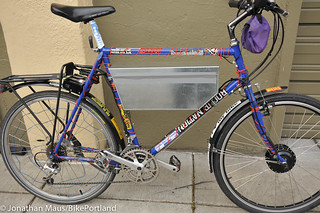
are more common than e-bikes off the showroom floor.
(Photo by J. Maus/BikePortland)
After years of being theoretically exciting, electrically assisted bikes are finally becoming common in the United States — enough for people to start studying their many benefits.
A new study by John MacArthur of OTREC at Portland State University offers some early results about the people e-bikes serve, the ways they get used and their possible role in reducing auto dependence in U.S. cities.
Here are a few useful facts from MacArthur’s presentation (PDF) at a PSU Friday transportation seminar last month:
1) Converting a bike to an e-bike is slightly more common than buying an e-bike from scratch. 48 percent of e-bike users purchased an e-bike, whereas 52 percent converted a standard bike (most commonly a mountain bike, but 13 percent of them a cargo bike or Xtracycle) by adding a battery and motor.
2) E-Bike conversions are usually cheaper than purchases, but not always. 70 percent of e-bike conversions and 46 percent of e-bike purchases were done for $1500 or less.
3) E-bike trips seem especially good at replacing car trips. The most common reason to go electric was to replace some car trips, though health, ability and comfort were also common reasons people took up e-bikes.
4) E-bikes turn people into daily riders. 55 percent of e-bikers rode their standard bike weekly or daily before the purchase. After the purchase, weekly or daily biking rose to 93 percent. Even the few (6%) who had never ridden bikes as an adult were now riding weekly or daily.
5) The biggest complaint with e-bikes is their weight. About 26 percent of respondents called it the main downside. (Another 8 percent, meanwhile, said there was no downside to riding an e-bike.) Fewer than 5 percent cited fear of theft or battery charging time.
Keep in mind that the 553 e-bike owners in this survey were reached via email, retailers, blogs, web forums, social media, meaning this is a disproportionately engaged and passionate audience. Still, many of the findings are worth thinking about, both for consumers considering e-bike purchases and for policymakers thinking about the benefits of promoting e-bikes.
Finally, here’s my favorite slide from MacArthur’s presentation, summarizing the potential for e-bikes to change the demographics of bicycle lovers:
I’m looking forward to the first time Ms. Strong and Fearless blows past me while I’m climbing Southeast Ankeny.


